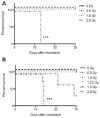Evidence for radiation-induced disseminated intravascular coagulation as a major cause of radiation-induced death in ferrets
- PMID: 24495588
- PMCID: PMC4039181
- DOI: 10.1016/j.ijrobp.2013.12.001
Evidence for radiation-induced disseminated intravascular coagulation as a major cause of radiation-induced death in ferrets
Abstract
Purpose: The studies reported here were performed as part of a program in space radiation biology in which proton radiation like that present in solar particle events, as well as conventional gamma radiation, were being evaluated in terms of the ability to affect hemostasis.
Methods and materials: Ferrets were exposed to 0 to 2 Gy of whole-body proton or gamma radiation and monitored for 30 days. Blood was analyzed for blood cell counts, platelet clumping, thromboelastometry, and fibrin clot formation.
Results: The lethal dose of radiation to 50% of the population (LD50) of the ferrets was established at ∼ 1.5 Gy, with 100% mortality at 2 Gy. Hypocoagulability was present as early as day 7 postirradiation, with animals unable to generate a stable clot and exhibiting signs of platelet aggregation, thrombocytopenia, and fibrin clots in blood vessels of organs. Platelet counts were at normal levels during the early time points postirradiation when coagulopathies were present and becoming progressively more severe; platelet counts were greatly reduced at the time of the white blood cell nadir of 13 days.
Conclusions: Data presented here provide evidence that death at the LD50 in ferrets is most likely due to disseminated intravascular coagulation (DIC). These data question the current hypothesis that death at relatively low doses of radiation is due solely to the cell-killing effects of hematopoietic cells. The recognition that radiation-induced DIC is the most likely mechanism of death in ferrets raises the question of whether DIC is a contributing mechanism to radiation-induced death at relatively low doses in large mammals.
Copyright © 2014 Elsevier Inc. All rights reserved.
Figures




Similar articles
-
Mechanism of hypocoagulability in proton-irradiated ferrets.Int J Radiat Biol. 2013 Oct;89(10):823-31. doi: 10.3109/09553002.2013.802394. Epub 2013 Jun 10. Int J Radiat Biol. 2013. PMID: 23651328 Free PMC article.
-
Evidence of Disseminated Intravascular Coagulation in a Porcine Model Following Radiation Exposure.Life Sci Space Res (Amst). 2014 Oct 1;3:1-9. doi: 10.1016/j.lssr.2014.07.001. Life Sci Space Res (Amst). 2014. PMID: 25197627 Free PMC article.
-
Variable hematopoietic responses to acute photons, protons and simulated solar particle event protons.In Vivo. 2008 Mar-Apr;22(2):159-69. In Vivo. 2008. PMID: 18468399
-
Trauma, shock, and disseminated intravascular coagulation: lessons from the classical literature.Ann Surg. 2011 Jul;254(1):10-9. doi: 10.1097/SLA.0b013e31821221b1. Ann Surg. 2011. PMID: 21368657 Review.
-
Pathogenesis and diagnosis of disseminated intravascular coagulation.Int J Lab Hematol. 2018 May;40 Suppl 1:15-20. doi: 10.1111/ijlh.12830. Int J Lab Hematol. 2018. PMID: 29741245 Review.
Cited by
-
Commonalities Between COVID-19 and Radiation Injury.Radiat Res. 2021 Jan 1;195(1):1-24. doi: 10.1667/RADE-20-00188.1. Radiat Res. 2021. PMID: 33064832 Free PMC article. Review.
-
Establishment of a mouse model of 70% lethal dose by total-body irradiation.Lab Anim Res. 2016 Jun;32(2):116-21. doi: 10.5625/lar.2016.32.2.116. Epub 2016 Jun 24. Lab Anim Res. 2016. PMID: 27382380 Free PMC article.
-
A Review of Radiation-Induced Coagulopathy and New Findings to Support Potential Prevention Strategies and Treatments.Radiat Res. 2016 Aug;186(2):121-40. doi: 10.1667/RR14406.1. Epub 2016 Jul 26. Radiat Res. 2016. PMID: 27459701 Free PMC article.
-
Limitations in predicting the space radiation health risk for exploration astronauts.NPJ Microgravity. 2018 Apr 3;4:8. doi: 10.1038/s41526-018-0043-2. eCollection 2018. NPJ Microgravity. 2018. PMID: 29644336 Free PMC article. Review.
-
Amivantamab for Metastatic Lung Cancer With Paraneoplastic Disseminated Intravascular Coagulation: A Case Report.Cureus. 2023 Jan 21;15(1):e34033. doi: 10.7759/cureus.34033. eCollection 2023 Jan. Cureus. 2023. PMID: 36814728 Free PMC article.
References
-
- Lawler A. Obama backs new launcher and bigger NASA budget. Science. 2010 Jan 1;327(5961):18. - PubMed
-
- Todd P. 2003. Space radiation health: a brief primer. Gravit Space Biol Bull. 2003 Jun;16(2):1–4. - PubMed
-
- Hu S, Kim MH, McClellan GE, Cucinotta FA. Modeling the acute health effects of astronauts from exposure to large solar particle events. Health Phys. 2009 Apr;96(4):465–76. - PubMed
-
-
XXXX
-
Publication types
MeSH terms
Substances
Grants and funding
LinkOut - more resources
Full Text Sources
Other Literature Sources

